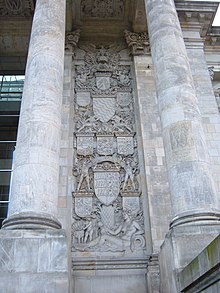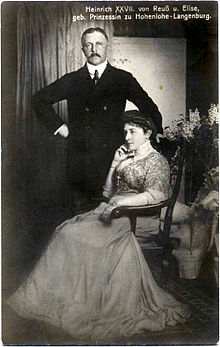Reuss younger line
|
||||||||||||||||||||||||||||||||||||||||
The Principality of Reuss Younger Line was a small state in the east of today's Thuringia, with Gera as the state capital . It was created in 1848 with the reunification of the three Russian rulers of the younger line Schleiz , Lobenstein-Ebersdorf and Gera .
history

Reuss younger line was next to Reuss older line one of the two main branches of the Reuss Princely House . 1802 died with Heinrich XXX. the last count from the Reuss-Gera younger line. The younger lines Reuss-Schleiz , Reuss-Lobenstein and Reuss-Ebersdorf jointly took over the reign of Gera. Already in 1824, however, became extinct with the death of Heinrich LIV. the Reuss-Lobenstein line, the territory of which fell on the Reuss-Ebersdorf line. This line renounced in 1848 with the resignation of Prince Heinrich LXXII. in favor of the Reuss-Schleiz line, which resulted in the unified principality of Reuss younger line.
In the succession of the partial rulers who were elevated to principalities until 1806, Reuss j. L. also Principality, member of the German Confederation and member of the Customs and Trade Association of the Thuringian States, member of the German Customs Association . In 1849, as a constitutional monarchy , the new principality received a constitutional law and an electoral law with indirect elections to the Reuss younger line parliament . Conservative revisions of the progressive constitutional constitution took place in 1852 and 1856. Since 1854 the domain property , consisting in particular of forests, was the sole property of the Princely House, with its own administration. This led to the formation of a state within a state. The income from the domain in 1913 was 713,000 marks.
In the German War of 1866 the principality was initially neutral, but then, in contrast to Reuss older line, on the side of the Kingdom of Prussia . On June 28, it entered the prospective North German Confederation through a voluntary contract with Prussia and left the German Confederation on July 2 . As a result, part of the sovereignty , namely the independent foreign policy, the determination of economic questions of principle and the military sovereignty, was given up in 1867 . In 1871, with the establishment of the empire, the “ Prussian system” of the North German Confederation was transferred to the newly created nation state and Reuss j. L. thus to the federal state in the German Empire . When in 1880 the federal states were obliged to set up permanent representations at the Bundesrat in Berlin, the Principality transferred its representation to the Grand Duchy of Saxony-Weimar-Eisenach . With the restructuring of the court organization in the Reich in 1877, the Principality of Gera received its regional court .
After the electoral reform in 1871, the state parliament consisted of 16 members, one of whom was appointed by Prince Reuss-Köstritz , three from the highest taxable and twelve from the other male community citizens were elected directly in one constituency . To defend against social democracy, however, this was changed in 1912 by increasing the number of members from general elections from 12 to 17. At the same time, however, plural voting rights were introduced, which took income, age and level of education into account. Up to five voices could be concentrated on one person.
In 1863 freedom of trade was introduced in the principality, in 1905 only in Reuss j. L. (and Prussia ) a department store tax to secure petty bourgeois livelihoods.
Due to the rapidly expanding textile industry , the population in the district of Gera increased by 144.3% between 1871 with 40,721 inhabitants and 1900 with 99,594 inhabitants; this corresponded to a population density of 406 inhabitants / km². At the turn of the century, there was stagnation.
After the fall of the monarchy and the proclamation of the Republic in the November Revolution 1918 Prince declared on November 11, Heinrich XXVII. also as regent of the Principality of Reuss older line, his renunciation of the throne. Reuss j. L. became a free state , but in 1919 it was united with the Free State of Reuss Ä. L. to form the People's State of Reuss with the capital Gera , which in turn became part of Thuringia in 1920.
economy
Reuss j. With Gera, L. had the center of the textile industry in East Thuringia. In 1891 there were 62 textile factories with a turnover of 50 million marks and 10,834 workers. The most important factory was the Ernst Friedrich Weißpflog company founded in 1834. Gera was also the center of mechanical engineering with the factories of Moritz Jahr (founded 1841), Alfred Kuhn (founded 1858), August Jahn (founded 1873) and Karl Wetzel (founded 1877). Therefore, like other areas of Thuringia and Saxony, the principality was a stronghold of the labor movement and the SPD .
Administrative division and population
- Population: 139,210 (1900)
- Cities: Gera , Köstritz , Ebersdorf , Schleiz , Lobenstein , Saalburg , Tanna , Hirschberg
- District office districts: Lower Land District Gera , Upper Land District Schleiz (with praise stone)
- Exclaves: Triebes , Hohenleuben , Pohlen
- Places with more than 2,000 inhabitants in 1910
| place | Residents Dec. 1, 1910 |
|---|---|
| Gera | 49,276 |
| Debschwitz * | 7,693 |
| Lower House * | 7,376 |
| Schleiz | 5,564 |
| Zwötzen * | 5,361 |
| Instinct | 4,965 |
| Gates * | 3,537 |
| Langenberg * | 3,297 |
| Praise stone | 3.125 |
| Köstritz | 2,509 |
| Hirschberg | 2,457 |
| Langenwetzendorf | 2.213 |
| Tanna | 2,032 |
* Locations belonging to Gera today.
Currency and mail shelf
The Principality joined the Dresden Mint Treaty in 1838 . Two dollars in the Prussian 14-taler monetary standard now corresponded to 3 1 / 2 South German Gulden in 24 1 / 2 -Gulden-feet, which should be considered as common club coin of the "contra end here states". This club coin of "2 Taler = 3 1 ⁄ 2 Gulden" was legally valid in every Zollverein country - regardless of who the respective issuer of the club coin was. Several Reuss lines minted their own coins in the Prussian coinage system (1 Reichstaler at 24 groschen at 288 pfennigs, from 1838 1 taler at 30 silver groschen at 360 pfennigs):
- Reuss older line (Reuss-Greiz) 1806–1909, mints existed in Saalfeld before 1840, in Hanover 1875–1877, in Berlin 1840–1909,
- Reuss-Lobenstein-Selbitz 1807, Saalfeld Mint,
- Reuss-Lobenstein-Ebersdorf 1812–1847, Berlin Mint,
- Reuss younger line (Reuss-Schleiz-Gera) 1816–1884, Mints Saalfeld before 1840, Berlin 1840–1884.
It was only with the introduction of the mark as imperial currency on January 1, 1876 under the law of December 4, 1871, that the fragmentation of the monetary system was lifted.
The Thurn-und-Taxis-Post secured the post office shelf through contracts with the Principality of Reuss:
- March 17, 1809 with Reuss-Lobenstein and Reuss-Ebersdorf,
- March 21, 1809 with Reuss-Greiz,
- March 1, 1816 with Reuss-Schleiz
- March 1, 1817 with Reuss-Schleiz, Reuss-Lobenstein and Reuss-Ebersdorf because of the common rule of Gera.
The common administration could already be recognized from the outside by the name, the postal coat of arms and the uniforms, which differed by different collar colors. The name of the post office was: “Fürstlich Reusssche, Fürstlich Thurn und Taxissche Lehenspostexpedition”. The postal coat of arms therefore combined both coats of arms, below the Reusser, above the princely Thurn and Taxissche. From 1852 to 1866, the Thurn-und-Taxis-Post issued its own postage stamps in two different currencies. Reuss belonged to the Northern District with penny currency. From 1867 the mail shelf was transferred to Prussia.
Judiciary
The jurisdiction was incumbent on the higher regional court in Jena . It was responsible for the four Saxon-Ernestine states, the Principality of Schwarzburg-Rudolstadt and the two Russian principalities as well as the Prussian districts of Schmalkalden, Schleusingen and Ziegenrück. The Principality of Reuss younger line formed the district of the district court of Gera, also responsible for the Weimar district of Neustadt, with five district courts . The jury meetings were held in Gera for all of East Thuringia.
- District Court Gera (for Reuss younger line and the Neustädter Kreis of Saxony-Weimar-Eisenach) with the eight district courts Gera , Hirschberg , Hohenleuben , Lobenstein , Schleiz (for Reuss j. L.); Auma , Neustadt an der Orla , Weida (for the Neustadt district).
military
As a member of the German Confederation , the principality provided a contingent of 522 infantry and belonged to the 12th battalion of the reserve division of the armed forces . Since the establishment of the German Confederation, the two principalities jointly maintained a battalion of 745 infantry. In 1854 the strength of the peace was increased to six companies, with Reuss Ä. L. one hunter division of two, Reuss j. L. provided a battalion of four companies.
After the military convention concluded with Prussia on February 4, 1867 in the German Empire, together with the contingents of Sachsen-Altenburg and Schwarzburg-Rudolstadt, the princely Russian military of both lines formed the 7th Thuringian Infantry Regiment No. 96, which was part of the 4th Prussian Army Corps belonged in Magdeburg. A battalion was garrisoned in Gera , from which a small detachment was sent to Greiz every month.
coat of arms
Both principalities of Reuss had a common coat of arms. Blazon : The coat of arms consisted of a squared shield. In the fields:
- Fields 1 and 4: In black a standing golden lion. ( Bailiffs of Plauen as ancestors of the Principality of Reuss)
- Fields 2 and 3: A golden crane in silver. ( Rule of Kranichfeld . The Oberkranichfeld came in 1453 from the Burgraves of Kirchberg to the Reuss von Plauen , 1615 to Saxe-Weimar, 1620 to Schwarzburg, 1663 to Saxe-Gotha and finally in 1826 to Saxe-Meiningen. Nevertheless, the Princes of Reuss led the Crane prominent in the coat of arms.)
The national colors were black, red and gold.
Princes

- 1848–1854 Heinrich LXII. (1785-1854)
- 1854–1867 Heinrich LXVII. (1789–1867)
- 1867–1913 Heinrich XIV. (1832–1913)
- 1913–1918 Heinrich XXVII. (1858–1928)
The ordinal numbers of the ruler's names result from the fact that all male members of the Princely House had the first name Heinrich, the members of different branches of the Younger Line were counted in one sequence, but in view of the high numbers that were created in this way, each century started with I.
Other well-known representatives
- Heinrich XXIV. Prince Reuss zu Köstritz (composer)
- Heinrich LXIII. Prince Reuss zu Köstritz (oldest representative of the middle branch)
- Auguste Reuss zu Köstritz (Grand Duchess of Mecklenburg-Schwerin)
See also
- House Reuss (overview of the division of territories)
- Reuss family list
- Reuss middle line
- Reuss older line
literature
- Georg Brückner : Regional and Folklore of the Principality of Reuss younger line 1870. Reprint 1870/2011, Verlag Rockstuhl, Bad Langensalza, ISBN 978-3-86777-150-4 .
- Reuss . In: Meyers Konversations-Lexikon . 4th edition. Volume 13, Verlag des Bibliographisches Institut, Leipzig / Vienna 1885–1892, p. 758.
Web links
- Principality of Reuss younger line (Gera) 1806–1918
- Municipalities of the Principality of Reuss Younger Line 1910
- Search for Principality Reuss Younger Line in the catalog of the German National Library
- Search for Principality Reuss younger line in the German Digital Library
- Search for the Principality of Reuss Younger Line in the SPK digital portal of the Prussian Cultural Heritage Foundation
Individual evidence
- ↑ Ulrich Hess: History of Thuringia 1866 to 1914. Verlag Hermann Böhlaus Successor, Weimar 1991, ISBN 3-7400-0077-5 , p. 177.
- Jump up ↑ Heinrich Ambros Eckert and Dietrich Monten, Das deutsche Bundesheer, Volume II., Dortmund 1981, p. 17.





